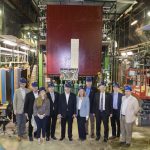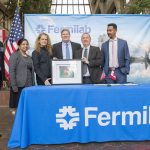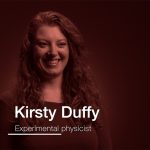This 3-minute video shows the highlights of the visit and statements made by a bipartisan delegation from the U.S. House of Representatives Committee on Science, Space, and Technology when they toured research facilities at the U.S. Department of Energy’s Fermi National Accelerator Laboratory on May 12, 2018. Five Members of Congress toured R&D facilities and discussed with Fermilab scientists the lab’s flagship neutrino research program. The video includes footage of Fermilab’s accelerator technology research areas, neutrino experiments located 350 feet underground, the Muon g-2 experiment, the lab’s quantum computing laboratory and remote control rooms for particle physics experiments. Statements were made by Energy Subcommittee Chairman Randy Weber (R-Texas), House Science Committee Vice Chairman Frank Lucas (R-Oklahoma), Representative Bill Foster (D-Illinois), Environment Subcommittee Chairman Andy Biggs (R-Arizona) and Representative Neal Dunn (R-Florida). Science Committee staff members also participated in the tour.
Anyone who has driven a car has an intuitive understanding of how velocities add. Two cars, heading towards one another head-on at a velocity, have a closing velocity of twice that velocity. It’s all very simple and yet at very high speeds this intuition is just wrong. In this 9-minute video, Don Lincoln explains how to add velocities in a relativistic environment. It’s weird and wonderful and mind-bending.
Her Excellency the Right Honorable Julie Payette, Governor General of Canada, visited Fermilab on April 26, 2018. The governor general toured the lab’s extensive research complex and celebrated the start of a new partnership between Fermilab and York University in Toronto in support of the Deep Underground Neutrino Experiment.
here’s so much we still don’t know about our universe and how it evolved into the place we call home. Why does matter exist all around us, and how do the tiniest particles fit into the big picture? A worldwide community has embarked on a journey to uncover the secrets of our world with the Deep Underground Neutrino Experiment. The project, powered by the Long-Baseline Neutrino Facility, will send neutrinos from the host laboratory, Fermi National Accelerator Laboratory in Illinois, to the Sanford Underground Research Facility in South Dakota. This video explores the excitement, the science, and the mysteries of DUNE.
Scientists on Fermilab’s Muon g-2 experiment are using a finely tuned clock to precisely measure how fast the muon — a heavy cousin of the electron — precesses, or wobbles, in the presence of a magnetic field. To remove subconscious bias from the experiment’s measurements, in March 2018, two Fermilab scientists outside the Muon g-2 collaboration set the clock to a certain frequency. For the period that Muon g-2 is taking data, only they will know that setting. This bias-removal technique is called clock blinding.
The 6,800-acre Fermilab site is home to a chain of particle accelerators that provide particle beams to numerous experiments and R&D programs. This 2-minute animation explains how the proton source provides the particles that get accelerated and travel through the accelerator complex at close to the speed of light. Scientists use these beams to generate protons, neutrons, muons, pions and neutrinos for various research areas across the Fermilab site. More than 4,000 scientists from over 50 countries use Fermilab and its particle accelerators, detectors and computers for their research.
There is no more famous conundrum in special relativity than the Twin Paradox. One twin travels at great distance at the speed of light and returns, much younger than the other twin. Yet who is moving and who isn’t? It is commonly claimed that acceleration is crucial to explaining this paradox, yet it turns out to not be the important point. In this 13-minute video, Don Lincoln explains the real answer to this perplexing puzzle.



